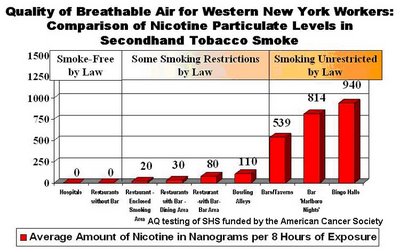American Cancer Society test results for secondhand smoke prove SHS is 532 - 25,000 times safer than OSHA regulations

American Cancer Society air quality testing data archived here.
Or Power Point version available here.
Also found online here.
The American Cancer Society measured the air quality for secondhand smoke in several venues. ACS tested by measuring the "marker" chemical in secondhand smoke -nicotine.* The results are shown above ranging from 20 -940 nanograms / cu. M. A nanogram is 10 (-9) of a gram or 0.000000001 of a gram which is also 0.000001 of a mg (milligram)

Full OSHA table here: http://www.osha.gov/pls/oshaweb/owadisp.show_document?p_table=STANDARDS&p_id=9992
The OSHA safe exposure level to airborne nicotine for an 8 hour per day, 40 hour per week is 0.5 mg/cu. M as per the partial OSHA table above.
So to determine what the American Cancer Society air quality testing really tells us, we compare the test results to the OSHA permissble exposure limits (pel).
OSHA safe level 0.5 mg divided by ACS result 20 nanograms, which is also 0.000020 of a mg. Thus, 0.5 /0.00002 = 25,000 times safer than OSHA regulations.
On the upper ACS reading we have OSHA safe level 0.5 mg divided by ACS result 940 nanograms, which is also 0.000940 of a mg. So, 0.5 /0.00094 = 532 times safer than OSHA regulations.
And so, what the American Cancer Society has proven in conducting air quality testing of secondhand smoke is that secondhand smoke absolutely does not constitute a health hazard justifying a government mandated smoking ban.
Especially when you realize that all the groups pushing for smoking bans are funded by pharmaceutical nicotine interests who profit in selling smoking cessation products after a smoking ban is passed.
* (As per air quality researchers nationwide) Nicotine is the only unique or "trace" chemical in secondhand smoke. If you measured for formaldehyde, the carpet and other interior sources of formaldehyde would corrupt the test result, formaldehyde is formed naturally in our atmosphere due to photochemical oxidation. Benzene is given off from burning foods in the kitchen or diesel exhaust outdoors so again a false reading would be obtained. Therefore, nicotine is the ideal chemical to measure to determine secondhand smoke concentrations in the air. And then our comparison to OSHA guidelines is the logical manner in which to determine if secondhand smoke levels pose a health hazard, as you can see, according to OSHA, the authority on workplace safety, they do not.
Communications director Bob Moffit of the American Lung Association of Minnesota heralded this air quality testing as confirming -"what we've been saying for years......" The pro-smoking ban activists praised this type of air quality testing......until they found out that in comparison to the OSHA air quality guidelines, secondhand smoke levels are up to 25,000 times SAFER than required. Read more here.
If you wanted you could measure every airborne chemical in secondhand smoke and then compare them to OSHA guidelines for each specific chemical, the results would be the same, if not more dramatic. To wit, the tobacco companies provide more nicotine content in their products than any other of the alleged chemicals such as benzene, fomaldehyde, arsenic, etc.......isn't that what the tobacco trials confirmed?
Update: Oak Ridge National Laboratory testing confirms that air quality testing of secondhand smoke in bars and restaurants "...concluded that exposures to respirable suspended particulate matter (RSP), for example, were considerably below limits (safer than) established by the Occupational Safety and Health Administration (OSHA) for the workplace....." Though it needs to be pointed out that RSP testing is NOT the proper way to determine secondhand smoke air quality levels.....as we've demonstrated here.
And OSHA itself has stated regarding secondhand smoke:
"Field studies of environmental tobacco smoke indicate that under normal conditions, the components in tobacco smoke are diluted below existing Permissible Exposure Levels (PELS.) as referenced in the Air Contaminant Standard (29 CFR 1910.1000)...It would be very rare to find a workplace with so much smoking that any individual PEL would be exceeded."
-Letter From Greg Watchman, Acting Ass't Sec'y, OSHA, To Leroy J Pletten, PHD, July 8, 1997
UPDATE: Reason.com's Hit & Run coverage and comments regarding this story.Also see:
http://cleanairquality.blogspot.com/2007/04/bmj-published-air-quality-test-results.html
By the way, regarding the activist claims that tobacco smoke contains 4,000+ chemicals; you can find the facts debunking that scam here:
http://cleanairquality.blogspot.com/2004/04/truth-behind-activist-claims-that.html



 "Though we may not be able to protect your business property rights, we certainly support your Second Amendment Rights"
"Though we may not be able to protect your business property rights, we certainly support your Second Amendment Rights" 

<< Home